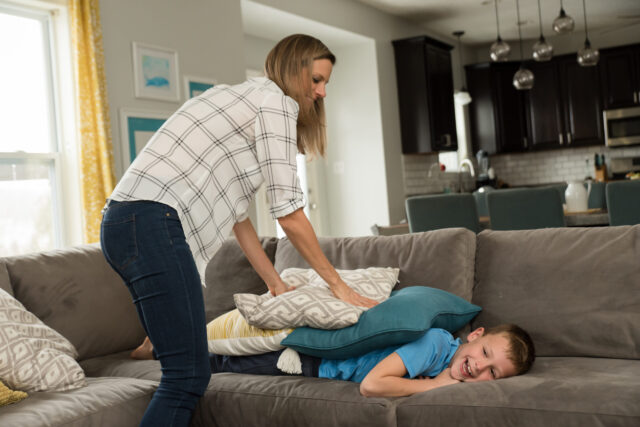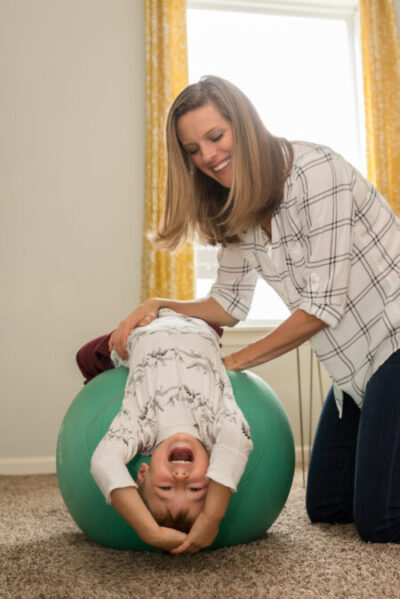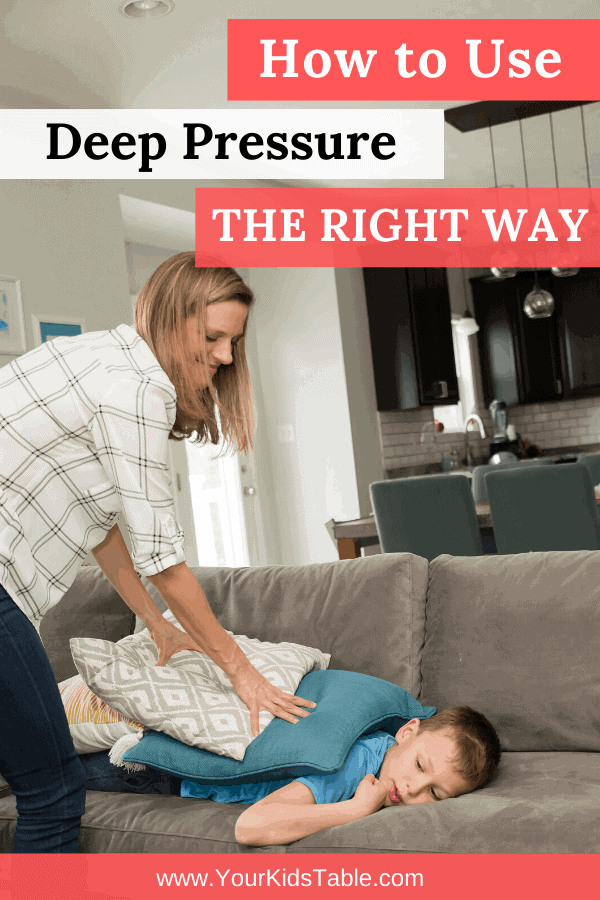Learn how to use deep pressure to help your kid calm down and focus. And, discover over 9 deep pressure activities you can use in your home.
Do you have a kid that loves to crawl into tight spaces? Do they give great big bear hugs? Or, maybe they love to hang on the jungle gym, letting their body dangle?
As parents, it’s easy to overlook those preferences and chalk them up to quirks, but there could be a reason you child climbs behind the couch.
And, it has everything to do with their sensory needs.
When kids seek out these types of experiences on a regular basis, they’re actually self regulating and that’s a really good thing. Because, when a child has a sensory need that they can’t get met it often results in tantrums, meltdown, or hyperactivity.
Sensory needs are wide and diverse, but when kids love tight squeezes, we’re specifically looking at a type of input called deep pressure.
Maybe that’s a new term to you, if so, you’re in the right place. Or, maybe you’ve heard of deep pressure as a good thing, but don’t really know when or why to use it. That’s what I want to teach you in this post, because as an occupational therapist, I know that deep pressure isn’t an effective sensory strategy for every kid.
In fact, it could make some things worse…
What is Deep Pressure?
Let’s get clear on exactly what deep pressure is.
Deep pressure is a way to provide input or sensations to the sensory system, particularly, the proprioceptive and tactile systems. Some ways that kids get deep pressure are:
- Pushing on people
- Fitting into tight spaces
- Laying under something heavy (think weighted blanket)
- Giving/getting hugs
- Hanging from a bar/rope/playground equipment
- Joint compressions
Deep pressure activities work like magic for some kids because they can help them calm down, relax, and focus.
Could Deep Pressure Help Your Child?

Just like any other sensory activity, deep pressure can be used for any child, they don’t have to have known sensory needs or any sort of diagnosis.
However, you’ll want to look for a few signs that it’s something your child might enjoy. Kids that love and respond to deep pressure typically are more active kids. They also are physical and initiate rough play. Many would also be described as affectionate.
That list isn’t a prerequisite though, it’s meant to give you clues to if it’s something you should try.
When NOT to Use Deep Pressure!!!
And, for most kids, I would offer deep pressure cautiously at first. It’s critical with any sensory activity to NEVER force it, even if you believe it’s something that will help your child.
We all process the sensations in and around us everyday a little differently. And, for some kids, especially those sensitive to tactile input or general sensory sensitivity, it could leave them feeling dysregulated.
That means that they’d have a hard time listening, paying attention, or follow directions. It could also cause your child to have that tantrum or meltdown because the sensory input was an aversion to their system.
And, while we ultimately want to develop kids sensory systems so that they are able to tolerate all sorts of input, deep pressure isn’t something they need to learn to love.
How to Use Deep Pressure the Right Way
Instead, I want you to think about using deep pressure for your child if they show signs of seeking it, because then we’re providing them with the sensations they need to regulate their sensory system. And, that’s critical for the many kids that spend their time feeling out of balance.
When kids feel regulated, and they aren’t busy trying to get those sensory needs met, they can focus on everything that’s expected of them at their age.
That’s playing with peers, communicating, eating well, getting a good night’s sleep, paying attention, learning new skills, and so much more.
Getting Started with Deep Pressure Activities
As I already mentioned, when you start a deep pressure activity, you want to take it slow. Deep pressure can include a lot of weight, which isn’t comfortable for some kids, so adding weight slowly and watching for their reaction is important. It’s typically pretty obvious if your child is enjoying it or not. Watch them closely for their reactions and even ask them how it feels.
Most kids that are going to have an averse effect will yell or tell you to stop. Respect that immediately.
It’s also helpful to show your child what the activity entails on yourself or somebody else. It may also be helpful to use sensory diet cards as well. The visual picture can help toddlers through teens choose an activity that’s best going to meet their needs. Head over to Sensory Diet Cards to learn more.
Affiliate links used below See our full disclosure.
3 Powerful Deep Pressure Activities for Kids
You’ve already read some deep pressure activities you can try with your child, and I encourage you to experiment with them. But, I wanted to give some additional activities and highlight a few that are really easy to do at home:
1. Roll a ball over your child while they lay on the floor face down
For a child that loves deep pressure, this is a dream. This activity can start out very slow too. Begin by steadily rolling a large yoga style ball from the tips of your child’s toes all the way up to their neck. Push down a little, but not very much. As you roll the ball back to the toes, ask your child if they’re liking it and if they want you to push harder.
2. Pull apart super strong putty
A great deep pressure activity you can do at the table is to use a therapy grade putty, like this one. This type of putty is created for building strength so it naturally provides a lot of deep pressure as it’s manipulated. You can hide small objects like pennies or beads inside that they need to dig out. Or, they can simply pull and twist, breaking off as much as they possibly can.
3. Create a tight space in your home that they can crawl into
The point is that their body is literally being squeezed by the wall or whatever container they can crawl into!
4. Do joint compressions
This is providing deep pressure directly by squeezing around the joints. For example, you can place a hand on each side of the elbow and then push back and forth towards the elbow. You would repeat this on the wrists, shoulder, knees, and ankles if your child so desires. Check out a full joint compression tutorial here.
5. Shake the sillys out
A quick way to provide joint compression and deep pressure is to grab your child wrists firmly, look them in the eye, and shake their arms up and down. I like to make it fun and will often say, “Let’s shake the sillys out!”

6. Hang upside down
You can use a large ball like in the picture or have your child lay over the cushions on the couch. Monkey bars work good too if you’re there to spot your child. The hanging provides a lot of deep pressure to the head, torso, and limbs.
7. Use a weighted blanket or weighted lap pad
Both of the sensory toys/tools give direct deep pressure input. They’re particularly helpful for kids that have trouble sleeping (and seek out deep pressure) or sitting still in a chair (use the weighted lap pad). Learn more about weighted lap pads.
8. Give your child a big deep hug
Make sure you squeeze them firmly. Remember to ease into this as well, and if you already know your kid isn’t much of a hugger, then skip this one.

9. Get inside a body sock
This is a classic sensory toy. Basically, your child climbs inside a large stretchy pillowcase with a circle cut out for their face, see it here. When they get inside and stretch out their arms and legs, the body sock fabric pushes back providing steady deep pressure input.
Now you know what deep pressure is, when, and how to use it! Lots of ideas were shared throughout this post for giving deep pressure, but if you have any other ideas, please share them in the comments below!
Learn How to Use More Sensory Activities to Help Your Child
Sensory is powerful when you know how to use it, and there are activities to use and avoid to help your child learn, grow, play, and communicate to the best of their ability. In my free workshop, 3 Expert Secrets to Calm + Focus Your Child with Expert Sensory Activities. Plus, when you save your seat we’ll send you a free printable workbook!
Click here to get a spot in the free sensory workshop!
More on Deep Pressure
Genius Hacks to Survive the Holidays with Sensory Kids
7 Awesome Sensory Activities Using a Yoga Ball
Simple Calming Activities for Active or Overwhelmed Kids to Start Today!
Alisha Grogan is a licensed occupational therapist and founder of Your Kid’s Table. She has over 15 years experience with expertise in sensory processing and feeding development in babies, toddlers, and children. Alisha also has 3 boys of her own at home. Learn more about her here.

Thank you for this post! I have a question, if a child likes submerging a lot and jumping in the sofa back and forth what sensation is he looking for? Where can I read more about this topic? Thanks for the help
Hi Caroline,
This could be a mixture of proprioceptive and vestibular seeking input. I’m linking 2 articles on each topic for you to look over. I hope this helps!
Laura
Your Kid’s Table team member
I am a 61 yr old just recently learning why certain activities appeal and have always appealed to me. For ever I have desired tight places, wrapping myself in blankets or literally looking at everything as a possible means of satisfying those needs. Totally distracting, consuming, frustrating. I have learned of Temple Grandin, and of SPD. It seems as an adult I still struggle with meeting my sensory needs. After reading about joint compressions, I now understand why I so enjoy flexing and straining my wrists, elbows and shoulders against my wrappings. Also as a guitar player, if I cant or dont play for a few days, I’m looking for input, my go to activity is raking the yard. Even at 10 pm. When I need it , I need it..cant sleep. Etc. Im learning about self regulation. And sensory input needs from sites like yours. SPD life, and others. Thanks.
Awesome David, so glad you are learning from our site and working through everything to understand and know what works for you! Thanks so much for sharing your story!
Best,
Desiree
wow so much to learn.i am so amaze at up skilling and to read more to see the new changers and what to do for this wonderful children with so many challengers
Awesome!! Thanks for letting us know!! So happy this is helpful for you 🙂